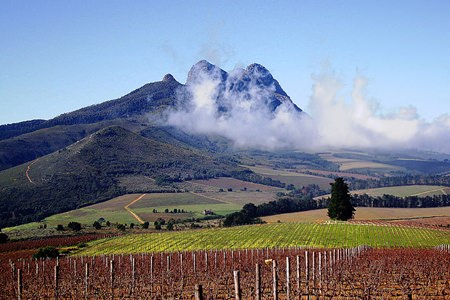When the Dutch settlers first attempted to make wine in South Africa in the 1650s, it was not a spectacular success. By all accounts, it was undrinkable. Wine production didn’t really improve very much until the French Huguenots arrived with their viticultural skills and knowledge. Then in 1679 the new governor, Simon van der Stel established the foundation for what was to become the town of Stellenbosch and one of the centres of the present day South Africa wine industry. His own estate of Constantia became well-known for the so-called Vin de Constance, an exceptional dessert wine made from Muscat grapes. During the eighteenth and nineteenth centuries it was widely exported to Europe and enjoyed by Frederick the Great, Napoleon and anyone else who could afford to drink it. The wine even got a mention in a novel by Jane Austin and an unfinished one by Charles Dickens.
Production of this fabled wine stopped during the nineteenth century as a result of the Phylloxera epidemic but it resumed again in 1986. Today Vin de Constance is one of the great dessert wines of modern times. You can sometimes find it in specialist wine shops but you’ll probably need to take your credit card, because the 2006 vintage, for example, costs about $800 or Bt. 25,000 for a small bottle.
 Vineyards near Stellenbosch (Photo: Warrenski)
Vineyards near Stellenbosch (Photo: Warrenski)
I first came across South African table wines in the 1970s when the South African Co-Operative Wine Growers Association (better known as KWV) controlled the production of wines. In the 1980s, it fell out of favour when trade sanctions were placed on the country as a result of its apartheid policies and a few of my politically-aware friends in Britain refused to drink South African wines. Interestingly, it was Nelson Mandela who got the wine industry back on its feet again. Today, more than 250,000 people are employed in the industry and South African wine has enjoyed international attention and acclaim for its wide variety of styles.
Both the wines this week are from the Western Cape and named after a section of the N2 highway that runs through Cape Town and Port Elizabeth. This section is known as Settler’s Way. These wines – I would guess – come from one of the many cooperatives that exist in South Africa. There’s no year shown on the labels, so they are non-vintage wines, blended from wines of different years and quite likely wines from different vineyards. Don’t let this put you off because this is a very common practice among wines at the lower end of the price scale. And if the raw materials are up to scratch and the winemakers know what they are doing, there should not be a problem. Incidentally, both wines come with a screw closures which I have to admit I am getting to prefer more and more. They just make so much more sense than corks, especially with cheaper wines.
Settlers’ Way Chardonnay (white), South Africa (Bt. 425 @ Villa)
This wine is an attractive pale gold colour with a characteristic New World Chardonnay aroma. Actually, the aroma is probably its most attractive feature of this wine, with a creamy mix of tropical fruit, pineapple and peaches up front and a touch of orange grassiness in the background. On the palate, citrus flavours seem to be in charge, with notes of pineapple and a dash of pomelo-like acidity. It’s pretty dry and has a pleasant tangy quality that makes it crisp and refreshing. In fact it seems a little bit on the sharp side for a Chardonnay but it would probably work well as an apéritif before dinner, assuming of course, that you can still afford such extravagancies.
Nevertheless, this is a pretty basic wine and it would be fine with fairly simple food such as quiche, omelet or salads. At only 12.5% alcohol content it would go well with light roast chicken dishes too. It would be interesting to try with some Thai dishes especially if they contain chicken or fish. If like me, you are a regular reader of this column, you may recall that my dogs are also interested in wine. Ee-ah (the one who plays the clarinet) was particularly impressed with the aroma of this wine. Dogs of course have much more sensitive noses than humans so that really is a compliment. And yes, thank you, the clarinet studies are progressing well, although it might be some time before she is good enough to join the local amateur orchestra. Mind you, having heard them play the other night, perhaps it won’t.
Settlers’ Way Cabernet Sauvignon (red), South Africa (Bt. 425 @ Villa)
As soon as you open the bottle, you’ll probably smell the lovely gentle and enticing aroma of red fruit, cherries, plums and slightly jammy strawberries. There’s plenty of fruit on the palate with a tiny touch of acidity to give the wine a bit of a lift, very soft tannins and an attractive fruity finish. Actually, for a Cabernet Sauvignon it’s surprisingly light-bodied, though quite pleasant and undemanding. Perfect, as far as I am concerned, for the end of the week when quite frankly I can’t cope with too much of a challenge. It’s really a pretty basic wine with no pretensions to be anything else. It’s all too easy to be a bit sniffy about wines like this (and I can assure you that some critics can be extremely sniffy) but as far as I am concerned, sometimes a simple wine is just right when you want an easy glugger to go with salads or snacks. So if you want to try something dry, light and fruity without too much tannin, give this a try. Curiously, it comes with 14% alcohol content, which seems a bit high for such a light wine.
Incidentally, if you are not from Britain you may not know that BBC Radio used to broadcast a music show which ran in Britain until 2001 and presumably aimed at people of advancing years. It was called Sing something Simple and featured easy-listening songs of yesteryear tastefully performed by the Cliff Adams Singers, accompanied equally tastefully by Jack Emblow on his accordion. It was not my cup of tea in the slightest, but it became the longest-running continuous music programme in the world. I believe the programme ran for forty-two years.




